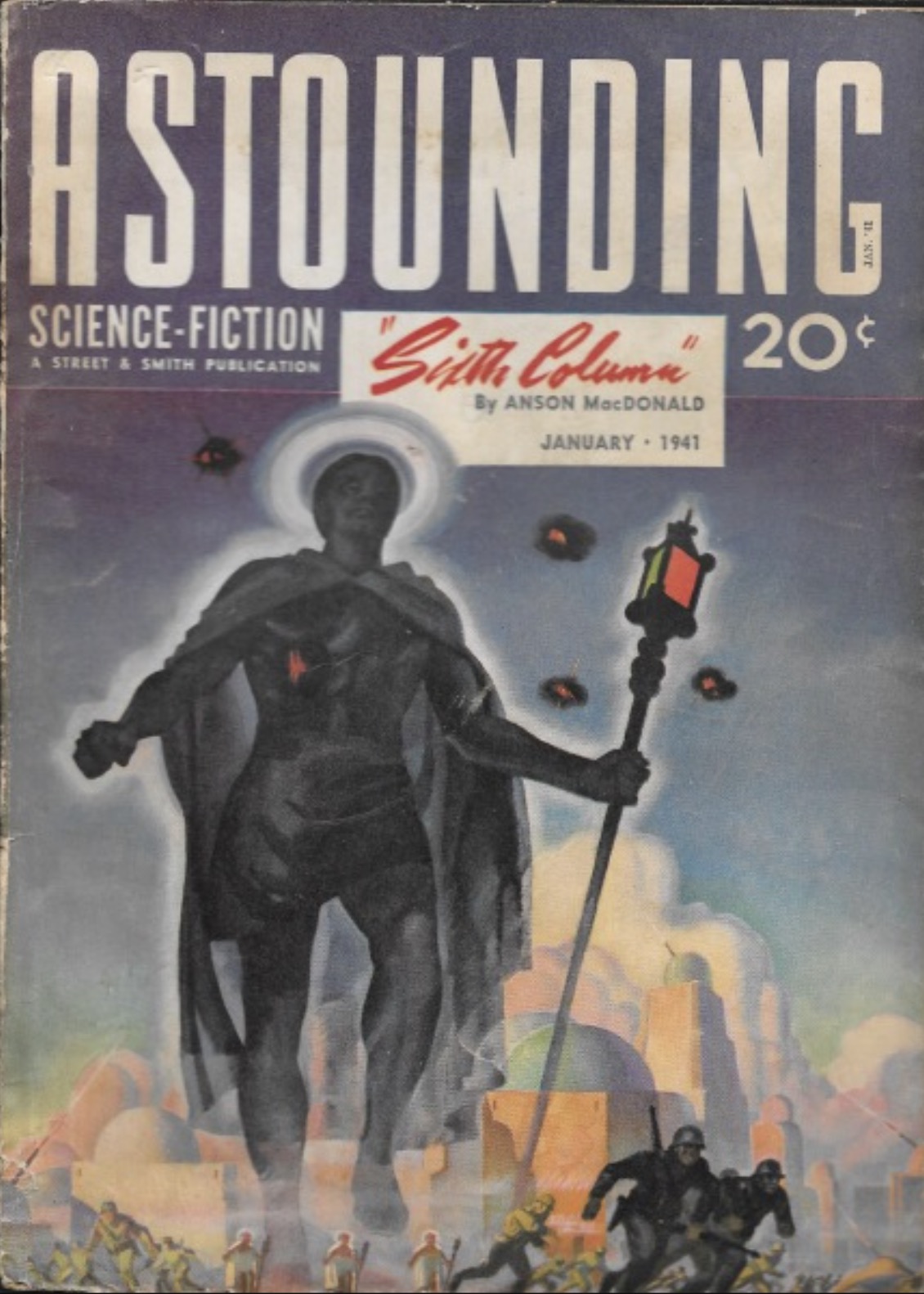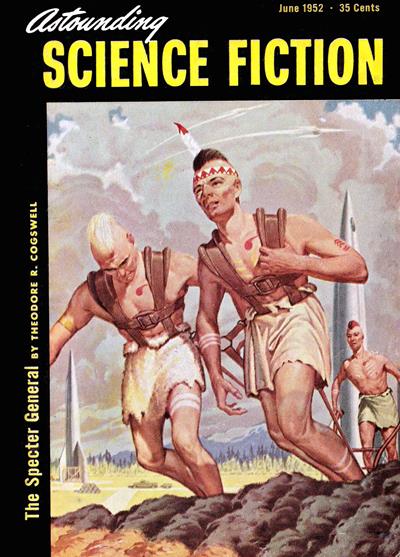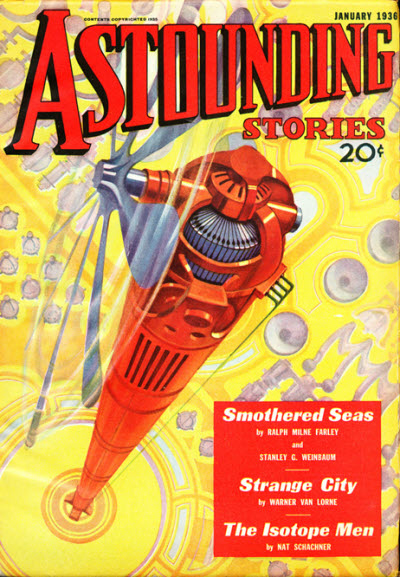
Part of Series
Vol 26, No 5. Contents: 5 • Invention • [Editorial (Astounding)] • essay by John W. Campbell, Jr. [as by The Editor] 9 • Sixth Column (Part 1 of 3) • serial by Robert A. Heinlein [as by Anson MacDonald] 42 • The Day We Celebrate • short story by Nelson S. Bond 54 • The Mechanical Mice • novelette by Maurice G. Hugi and Eric Frank Russell [as by Maurice G. Hugi] 73 • In Times to Come (Astounding, January 1941) • [In Times to Come (Astounding)] • essay by The Editor 73 • The Analytical Laboratory: November 1940 (Astounding, January 1941) • [The Analytical Laboratory] • essay by The Editor 74 • The Traitor • [Kilkenny Cats] • novelette by L. Ron Hubbard [as by Kurt von Rachen] 90 • Starting Point • essay by Norman R. Goldsmith 103 • Lost Rocket • short story by Manly Wade Wellman 115 • Book Review (Astounding, January 1941) • essay by John W. Campbell, Jr. 116 • The Opportunists • short story by E. A. Grosser 128 • Doom Ship • novelette by Harry Walton 155 • Letter (Astounding, January 1941) • essay by Bill Stoy 155 • Brass Tacks (Astounding, January 1941) • [Brass Tacks] • essay by The Editor 155 • Letter (Astounding, January 1941) • essay by Paul A. Carter [as by Paul Carter] 156 • Letter (Astounding, January 1941) • essay by Ralph Williams (I) 157 • Science Discussions (Astounding, January 1941) • essay by The Editor 158 • Letter (Astounding, January 1941) • [Letters: Isaac Asimov] • essay by Isaac Asimov 160 • Dead—and Embalmed • essay by John W. Campbell, Jr. [as by Arthur McCann]. 【 PREVIOUS ISSUE ← January 1941 → NEXT ISSUE 】
Authors


Isaac Asimov was a Russian-born, American author, a professor of biochemistry, and a highly successful writer, best known for his works of science fiction and for his popular science books. Professor Asimov is generally considered one of the most prolific writers of all time, having written or edited more than 500 books and an estimated 90,000 letters and postcards. He has works published in nine of the ten major categories of the Dewey Decimal System (lacking only an entry in the 100s category of Philosophy). Asimov is widely considered a master of the science-fiction genre and, along with Robert A. Heinlein and Arthur C. Clarke, was considered one of the "Big Three" science-fiction writers during his lifetime. Asimov's most famous work is the Foundation Series; his other major series are the Galactic Empire series and the Robot series, both of which he later tied into the same fictional universe as the Foundation Series to create a unified "future history" for his stories much like those pioneered by Robert A. Heinlein and previously produced by Cordwainer Smith and Poul Anderson. He penned numerous short stories, among them "Nightfall", which in 1964 was voted by the Science Fiction Writers of America the best short science fiction story of all time, a title many still honor. He also wrote mysteries and fantasy, as well as a great amount of nonfiction. Asimov wrote the Lucky Starr series of juvenile science-fiction novels using the pen name Paul French. Most of Asimov's popularized science books explain scientific concepts in a historical way, going as far back as possible to a time when the science in question was at its simplest stage. He often provides nationalities, birth dates, and death dates for the scientists he mentions, as well as etymologies and pronunciation guides for technical terms. Examples include his Guide to Science, the three volume set Understanding Physics, and Asimov's Chronology of Science and Discovery. Asimov was a long-time member and Vice President of Mensa International, albeit reluctantly; he described some members of that organization as "brain-proud and aggressive about their IQs" He took more joy in being president of the American Humanist Association. The asteroid 5020 Asimov, the magazine Asimov's Science Fiction, a Brooklyn, NY elementary school, and two different Isaac Asimov Awards are named in his honor.

Works of American science-fiction writer Robert Anson Heinlein include Stranger in a Strange Land (1961) and The Moon Is a Harsh Mistress (1966). People often call this novelist "the dean of science fiction writers", one of the most popular, influential, and controversial authors of "hard science fiction." He set a high standard for science and engineering plausibility and helped to raise the standards of literary quality of the genre. He was the first science-fiction writer to break into mainstream, general magazines such as The Saturday Evening Post, in the late 1940s. He was also among the first authors of bestselling, novel-length science fiction in the modern, mass-market era. Also wrote under Pen names: Anson McDonald, Lyle Monroe, Caleb Saunders, John Riverside and Simon York.

Lafayette Ronald Hubbard With 19 New York Times bestsellers and more than 350 million copies of his works in circulation, L. Ron Hubbard is among the most enduring and widely read authors of our time. As a leading light of American Pulp Fiction through the 1930s and '40s, he is further among the most influential authors of the modern age. Indeed, from Ray Bradbury to Stephen King, there is scarcely a master of imaginative tales who has not paid tribute to L. Ron Hubbard. Then too, of course, there is all L. Ron Hubbard represents as the Founder of Dianetics and Scientology and thus the only major religion born in the 20th century. While, as such, he presents the culmination of science and spiritual technology as embodied in the religion of Scientology. For an in-depth look at his life, visit www.LRonHubbard.org



